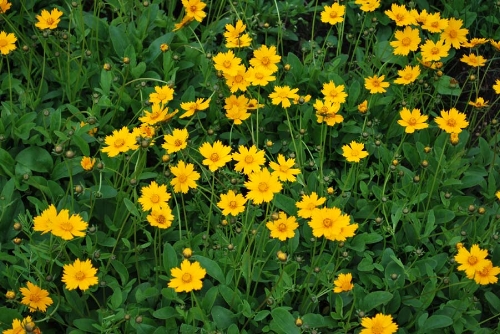Coreopsis (Coreopsis auriculata)
Arabic name:كوريوبسيس
Coreopsis (Coreopsis auriculata) is a drought-tolerant evergreen perennial that yields a profusion of daisy-like rich yellow flowers from late spring to autumn. The flowers’ long and profuse blooming season lasts from April to October.
This easily grown member of the sunflower family is very popular due to its reputation for carefree growth. It also is tough enough to often be used on median strips along highways.
The genus name Coreopsis means ‘looks like a bug’ because the seeds have a resemblance to ticks, and auriculata means ‘eared’ in reference to the ear-like lobes at the base of many of the leaves.
Coreopsis grows to a height of 0.3m, with a spread of 0.3m. It is fast growing, taking six months to one year to reach its mature size.
Requirements: Grows in full sun. Prefers fertile, well-drained soil, but does well even in sandy soil.
Water usage: Little watering (once a week).
Appearance: Coreopsis is a bushy perennial with bright orange-yellow flower heads, 2.5 – 6cm wide, that rise well above the foliage. Oval to lance-shaped leaves are lobed and light green.
Coreopsis also has spreading stolons (stems that spread on top of, or just under the ground, like strawberries), which enable it to spread nicely without being invasive. In optimum growing conditions, it will spread in the garden by those stolons to form an attractive ground cover, but the spread is easy to check if undesired.
Notes on use: Grows well in pots or in window beds. Is best grown in borders with other plants as a foreground or edging. It also provides relatively short cut flowers.
Propagation: Propagate by seeds, softwood cuttings, or division of root crown in spring or summer. Plant tends to self-seed.
Potting: Grow in a mix with good drainage in full sun or partial shade.
Maintenance: Removing dead flower heads after bloom gives a second flush of flowering. Prompt removal of dead flower heads can be tedious for a large planting, but does tend to encourage additional bloom. Shearing in mid to late summer will promote an autumn re-bloom, and also removes any unkempt foliage.
Notes: The seeds attract birds, and the bright colored flowers attract butterflies.
The flower heads of the coreopsis also are a source of natural yellow and orange dye.
Image source: https://www.plantmorenatives.com/uploads/4/2/5/3/42539229/s308030450575347893_p96_i1_w1200.jpeg
Image source: http://flower.onego.ru/other/phlox/en_2796.jpg
This article is part of a series of articles prepared by the Center for the Study of the Built Environment (CSBE) on water conserving landscapes.
For additional information on water conserving gardens, visit the CSBE web site at www.csbe.org
Support for the CSBE project on water conserving landscapes is provided by WEPIA (Water Efficiency and Public Information for Action), a program being implemented in collaboration with the Ministry of Water and Irrigation and funded by the United States Agency for International Development (USAID).


